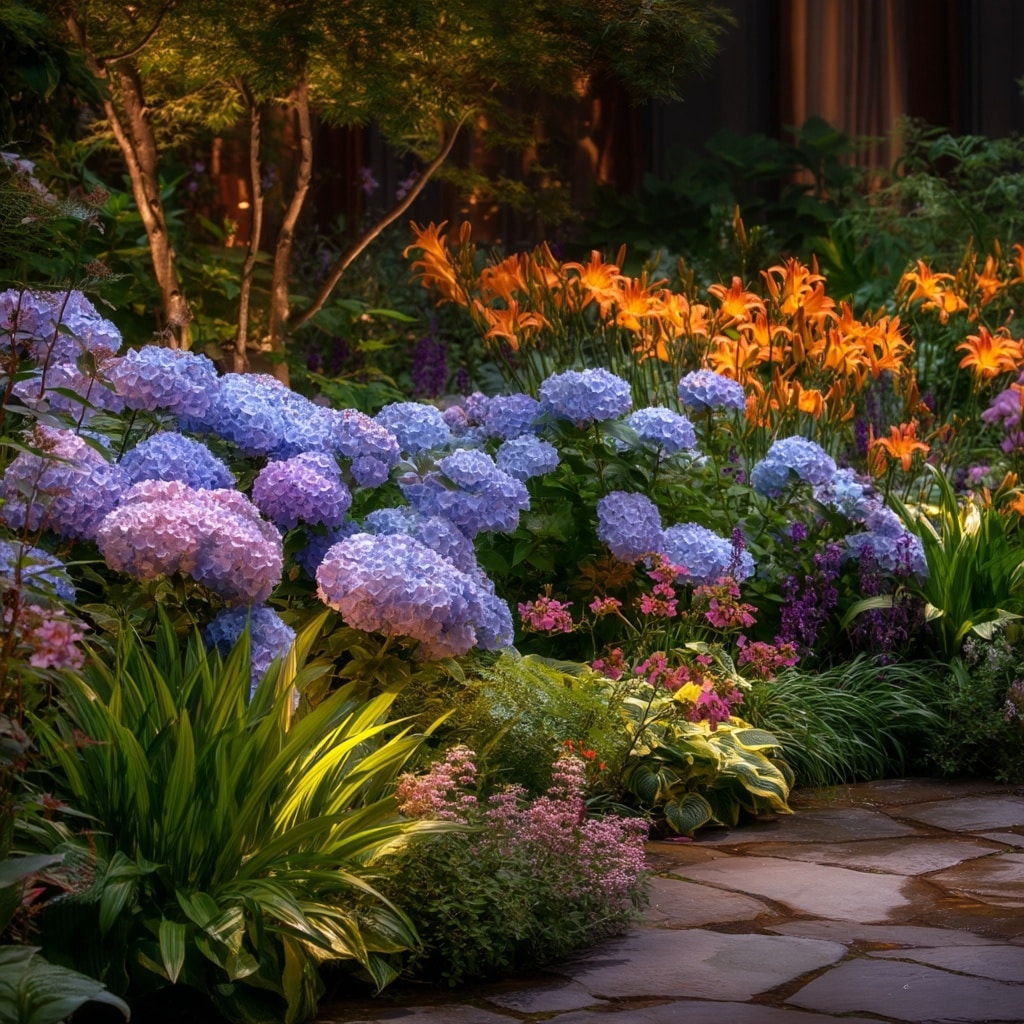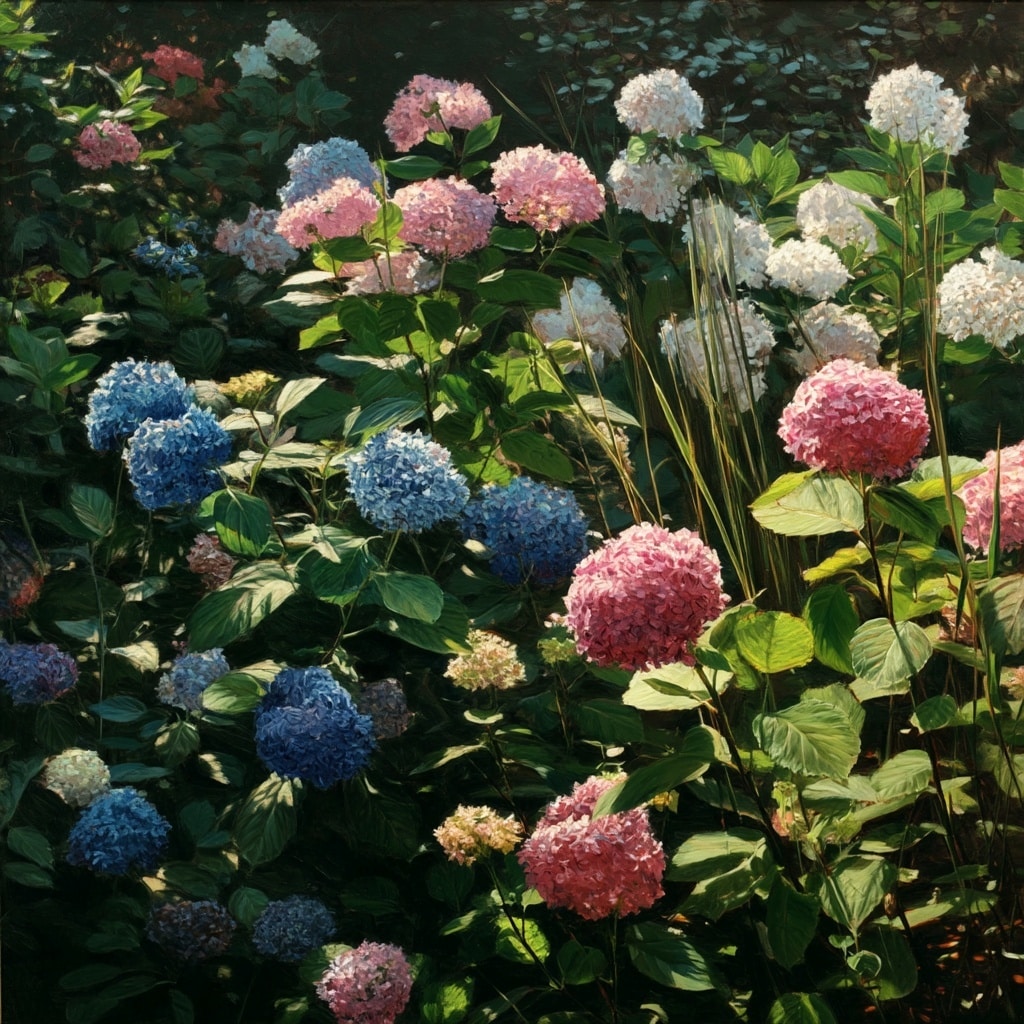Hydrangeas are beloved garden shrubs known for their lush blooms and graceful form, making them a favorite among both beginner and seasoned gardeners. With blossoms that span a stunning range of colors—from soft blues and purples to vibrant pinks, whites, and even lime greens—hydrangeas add charm and structure to any outdoor space.
These flowering shrubs typically bloom from early summer through fall, bringing months of vibrant color to gardens across USDA zones 3 through 9. Their versatility makes them suitable for borders, containers, hedges, and even as standalone statement plants. Whether you’re growing a dwarf variety on a balcony or planting a hedge of panicle hydrangeas in the yard, their beauty and low maintenance make them a garden staple.
In this guide, we’ll cover everything you need to know about growing, planting, and caring for hydrangeas—so you can enjoy healthy blooms year after year.
Table of Contents
Hydrangea Overview
Hydrangeas are a diverse group of shrubs with a surprising range of forms, colors, and growth habits. Before choosing the right type for your garden, it’s important to understand how different varieties behave, what conditions they prefer, and how they fit into your landscape design.
Growing Zones
Most hydrangeas thrive in USDA hardiness zones 3 to 9, making them adaptable to a wide range of climates. Cold-hardy varieties like smooth and panicle hydrangeas do particularly well in northern areas, while bigleaf and oakleaf types flourish in more temperate regions.
Size & Spread
Depending on the species, hydrangeas can be compact shrubs or large, spreading plants. Dwarf varieties stay around 3 feet tall and wide, ideal for containers or tight spaces. Larger types, like panicle or oakleaf hydrangeas, can grow up to 15 feet tall and 12 feet wide, offering impressive coverage for hedging or borders.
Sunlight Needs
Most hydrangeas prefer morning sun and afternoon shade, especially in warmer climates. In cooler zones, they can tolerate more direct sunlight. Too much shade, however, can lead to poor flowering, while too much sun may stress the plant and dry out the soil too quickly.
Bloom Time
Hydrangeas typically begin blooming in early summer and continue through the fall, depending on the variety and location. Some, like remontant types, may bloom multiple times in a season, especially with proper care.
Flower Color
One of the most unique traits of hydrangeas is their ability to change flower color based on soil pH—primarily seen in bigleaf (Hydrangea macrophylla) and mountain hydrangeas (Hydrangea serrata).
- Acidic soil (pH below 6.0) = Blue blooms
- Neutral to alkaline soil (pH 6.5 and above) = Pink or purple flowers
White, green, and red-flowering varieties are not affected by pH but still offer stunning color transitions as the flowers mature.
Types of Hydrangeas
There are six main types of hydrangeas grown in home gardens:
- Bigleaf (Hydrangea macrophylla) – Known for large, colorful blooms and pH-sensitive flowers.
- Oakleaf (Hydrangea quercifolia) – Distinctive foliage and white cone-shaped flowers that age to pink.
- Panicle (Hydrangea paniculata) – Hardy and sun-tolerant with cone-shaped blooms that age from white to pink or red.
- Climbing (Hydrangea anomala petiolaris) – A vining type perfect for walls or trellises.
- Smooth (Hydrangea arborescens) – Native to North America and known for large, round blooms like ‘Annabelle’.
- Mountain (Hydrangea serrata) – Smaller, more delicate shrubs ideal for woodland gardens.
Each variety has its own flower shape—mophead, lacecap, panicle, or snowball—adding even more diversity to your garden palette.
Blooming Habits
Hydrangeas can bloom on:
- Old wood (last year’s growth)
- New wood (this year’s growth)
- Both (reblooming varieties)
Knowing your hydrangea’s blooming pattern is crucial for proper pruning and maximizing flower production.
Planting Hydrangeas
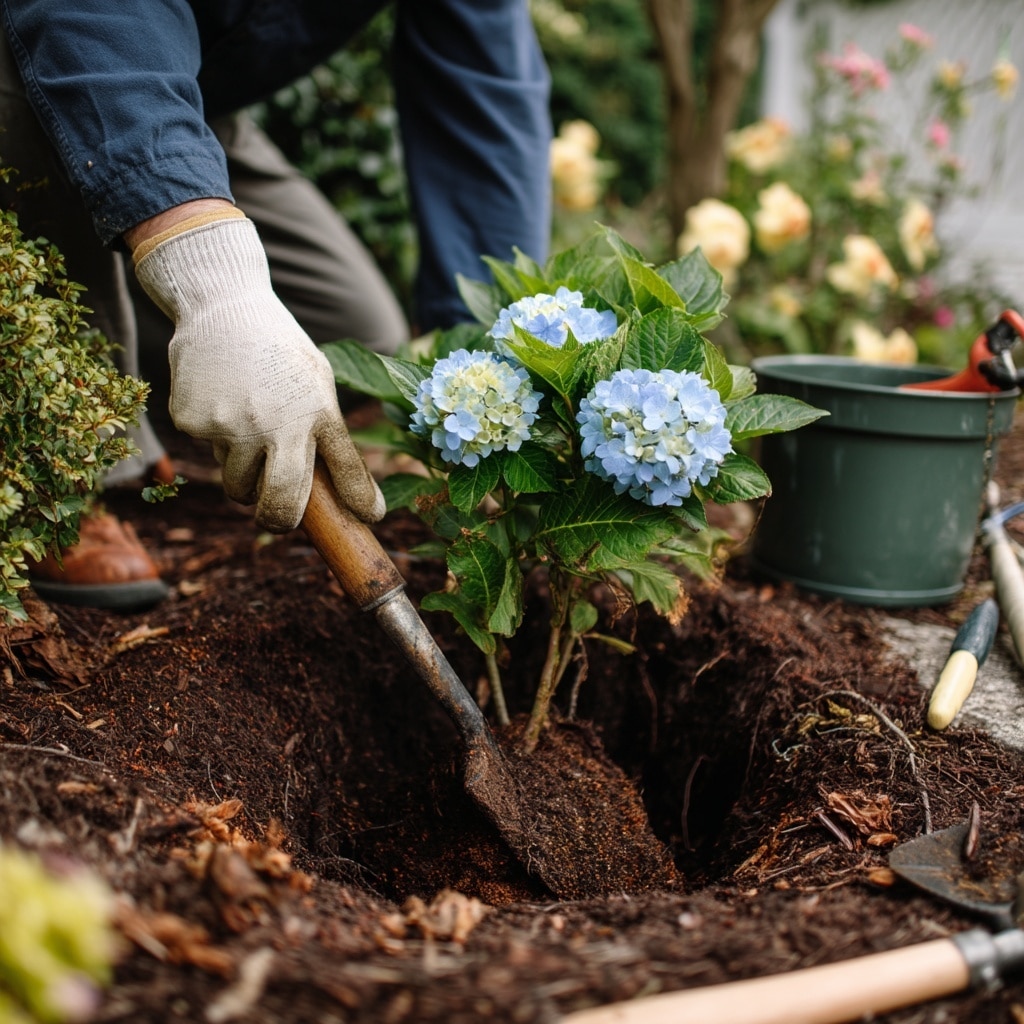
Getting your hydrangeas off to a healthy start begins with proper planting. Whether you’re adding a new shrub to your garden or relocating an established plant, following the right timing and techniques can make all the difference in long-term growth and flowering success.
When to Plant
The best time to plant hydrangeas is in early spring or fall, when temperatures are mild and plants have time to establish roots before extreme heat or frost. If planting in spring, wait until the threat of frost has passed. Fall planting should be done several weeks before the ground freezes.
Where to Plant
Choose a location that sets your hydrangeas up for success:
- Sunlight: Aim for a spot with morning sun and afternoon shade. In northern regions, more direct sunlight is usually fine. In hot southern areas, protect your plant from harsh afternoon rays.
- Soil: Hydrangeas love rich, well-draining soil. Avoid heavy clay or compacted areas unless amended with compost.
- Space: Give your plant room to grow. Check the mature size of your variety and allow at least 3 feet between shrubs—more for larger types.
- Air circulation: Avoid placing hydrangeas in areas with poor airflow or next to large trees, which can compete for water and sunlight.
- Protection: Shield them from strong winds that can damage tender stems and blooms.
How to Plant in the Ground
- Dig wide: Create a hole 2 to 3 times wider than the root ball but no deeper than the original pot.
- Loosen the roots: Gently untangle any potbound roots to encourage outward growth.
- Amend the soil: Mix in 15% organic compost and a bit of slow-release fertilizer. Use half the recommended dose to avoid shocking new roots.
- Position the plant: Set it slightly higher than ground level to allow for settling and avoid water pooling.
- Backfill and water: Fill the hole with amended soil, firm it gently, and water thoroughly to eliminate air pockets.
- Mulch: Add a 2–3 inch mulch layer to retain moisture and suppress weeds, keeping it a few inches away from the base of the plant.
Planting in Pots
Hydrangeas grow beautifully in containers, especially dwarf or compact varieties. Here’s how to do it right:
- Choose a large pot with good drainage holes.
- Use a high-quality potting mix—not garden soil.
- Mix in a slow-release fertilizer.
- Leave 1–2 inches of space at the top for watering.
- Select a location with bright but indirect light, and rotate the pot occasionally to ensure even growth.
- Water frequently, as potted hydrangeas dry out faster than those in the ground.
Container hydrangeas are perfect for patios, porches, or small gardens where you want a pop of seasonal color.
Hydrangea Care & Pruning
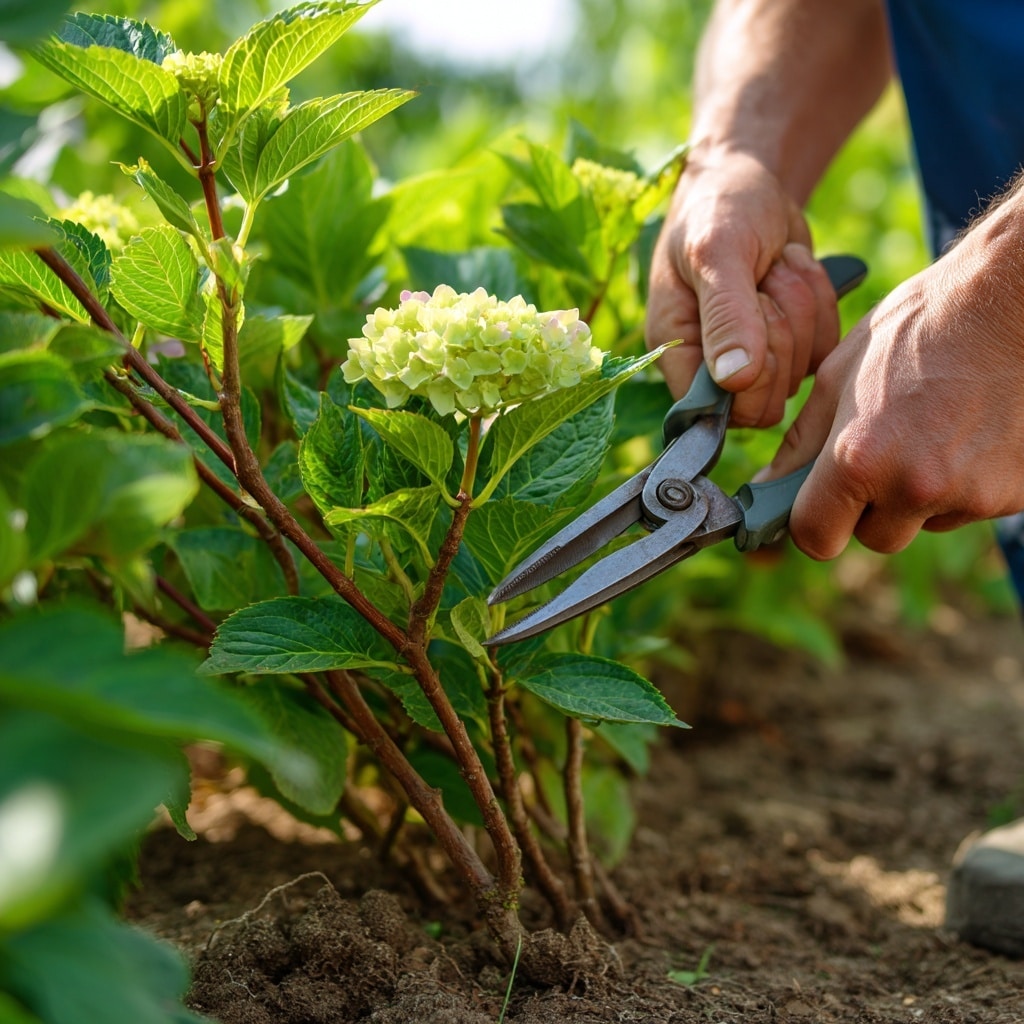
Caring for hydrangeas is relatively easy once they’re established, but a few key practices can help your plants thrive and bloom year after year. From watering and fertilizing to pruning and pest control, proper maintenance ensures a healthy shrub full of vibrant flowers.
Pruning Hydrangeas
Not all hydrangeas require heavy pruning—and some types can be damaged if pruned at the wrong time. Before cutting back your shrub, it’s important to identify which type you have and understand its blooming pattern.
- Bigleaf and oakleaf hydrangeas bloom on old wood. Prune these immediately after flowering in summer. Pruning in spring may remove next year’s flower buds.
- Panicle and smooth hydrangeas bloom on new wood. These can be pruned in late winter or early spring before new growth begins.
- Reblooming varieties may bloom on both old and new wood. Light pruning to shape and remove dead stems is best.
General pruning tips:
- Remove spent flowers to encourage tidy growth.
- Cut out dead, damaged, or crossing branches.
- Avoid over-pruning, which can reduce flowering.
Soil Requirements
Hydrangeas prefer moist, well-draining soil that’s rich in organic matter. Incorporating compost, aged manure, or leaf mold into the soil each year will help maintain fertility and structure.
- Bigleaf and mountain types can have flower color affected by soil pH, while panicle and smooth varieties are more pH-neutral.
- Clay-heavy soils should be amended with compost to improve drainage.
Fertilizing Hydrangeas
Feeding hydrangeas helps promote vigorous growth and larger, more colorful blooms. Use a balanced, slow-release fertilizer like 15-10-10, especially in early spring.
- Water well before and after applying fertilizer to prevent root burn.
- Over-fertilizing can result in lush leaves but fewer blooms—always follow product instructions carefully.
For containers, use a liquid fertilizer every 4–6 weeks during the growing season for best results.
Watering Tips
Hydrangeas have shallow roots and need consistent moisture, especially during hot weather.
- Water deeply 1–2 times per week, depending on rainfall.
- Keep the soil evenly moist, not soggy.
- Add 2–3 inches of mulch to retain moisture and prevent weed competition.
- Container-grown hydrangeas may need daily watering in summer.
Avoid watering the leaves in the evening to reduce the risk of mildew.
Pests & Diseases
Hydrangeas are generally resistant to serious pests, but some issues can arise:
- Aphids, spider mites, and Japanese beetles may appear on new growth or blooms.
- Fungal problems like powdery mildew, leaf spot, and bud blight can occur in damp, crowded conditions.
To prevent disease:
- Ensure good air circulation.
- Water at the base of the plant.
- Remove infected leaves and avoid overhead watering.
Natural or organic pest control methods are often sufficient, especially if caught early.
Why Hydrangeas Don’t Bloom
If your hydrangeas aren’t blooming, don’t panic—it’s a common issue with a few likely causes:
- Improper pruning—cutting back old wood can remove flower buds.
- Cold damage—a late spring frost can kill developing buds.
- Too much shade—not enough sunlight can prevent blooming.
- Over-fertilizing—too much nitrogen promotes leaves over flowers.
Check your plant type, location, and care practices to troubleshoot blooming problems effectively.
Popular Hydrangea Varieties
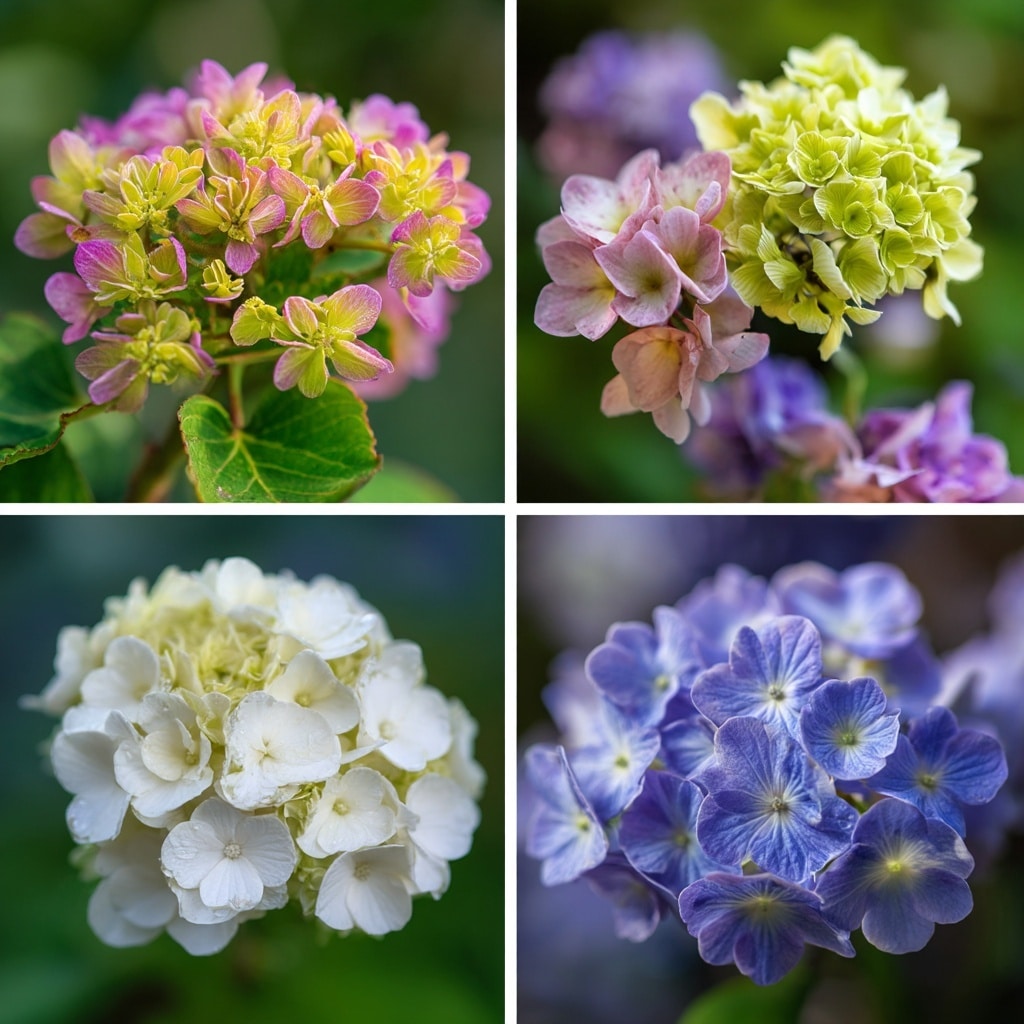
With so many types of hydrangeas available, it’s easy to find one that suits your garden style and climate. Whether you’re looking for compact varieties for containers or bold shrubs for borders, here are some standout cultivars that offer exceptional color, size, and bloom time.
Limelight Prime® (Hydrangea paniculata)
- Zones: 3–8
- Size: 4 to 6 feet tall, 4 to 5 feet wide
- Light: Full sun to part sun
- Bloom Time: Early summer through fall
- Color: Starts lime green, ages to pink-red
This compact version of the classic ‘Limelight’ is perfect for smaller spaces or colder climates. It blooms earlier and longer than many other panicle types, making it a reliable showstopper.
Endless Summer® (Hydrangea macrophylla)
- Zones: 4–9
- Size: 3 to 5 feet tall and wide
- Light: Part shade
- Bloom Time: Late spring through fall
- Color: Blue or pink (depending on soil pH)
One of the first reblooming hydrangeas, this variety flowers on both old and new wood. It’s a top choice for consistent blooms throughout the season.
Annabelle (Hydrangea arborescens)
- Zones: 3–9
- Size: 3 to 5 feet tall and wide
- Light: Part shade to full sun
- Bloom Time: Early summer through fall
- Color: White turning to soft green
Known for its massive, globe-like blooms, ‘Annabelle’ is a smooth hydrangea that performs well in a variety of conditions and is especially cold-hardy.
Tuff Stuff™ (Hydrangea serrata)
- Zones: 5–9
- Size: 2 to 3 feet tall and wide
- Light: Part shade
- Bloom Time: Late spring through fall
- Color: Blue or pink lacecap flowers
This mountain hydrangea is compact, cold-tolerant, and blooms reliably with minimal maintenance. It’s ideal for borders or mixed garden beds.
Snowflake (Hydrangea quercifolia)
- Zones: 5–9
- Size: 6 to 8 feet tall, up to 10 feet wide
- Light: Part shade
- Bloom Time: Early summer
- Color: White flowers that age to pink
Oakleaf hydrangeas like ‘Snowflake’ offer more than just beautiful blooms—they also provide dramatic fall foliage in shades of red, orange, and burgundy.
Whether you’re planting for size, color, or season-long flowers, these hydrangea varieties offer something for every garden. Don’t forget to match the plant’s needs with your local growing conditions to get the best results.
Landscaping with Hydrangeas
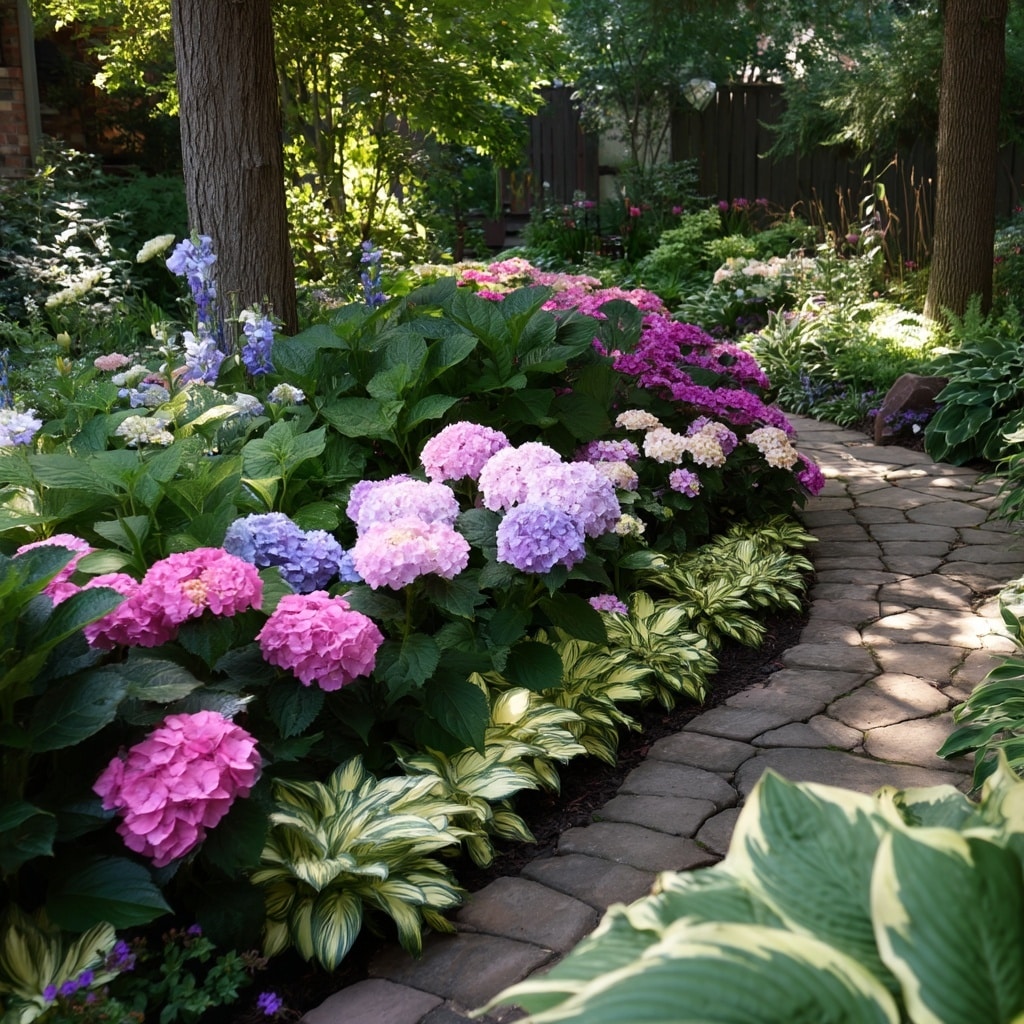
Hydrangeas are more than just beautiful blooms—they’re incredibly versatile plants that can elevate your landscape with bold color, structure, and seasonal interest. Whether you’re designing a cozy backyard border or a formal front yard display, hydrangeas can be adapted to nearly any garden style.
Using Hydrangeas in Garden Design
These flowering shrubs shine in a variety of landscape roles:
- Foundation plantings: Use compact varieties near the house for consistent color and structure.
- Hedges and privacy screens: Larger hydrangeas, like panicle or oakleaf types, work well as informal hedges or borders.
- Accent plants: Make a statement by planting a single bold hydrangea near an entryway or as a focal point in a mixed bed.
- Woodland gardens: Oakleaf and mountain hydrangeas thrive in partial shade and look natural beneath trees or along woodland edges.
- Slopes and banks: Their dense foliage helps control erosion and fill awkward spaces.
Hydrangeas in Containers
If space is limited, you can still enjoy hydrangeas in pots and planters:
- Choose dwarf or compact varieties (like Endless Summer® or Tuff Stuff™).
- Use stylish containers to match your décor.
- Move pots to shaded areas during peak summer heat to protect blooms.
- Rotate containers regularly for even sunlight exposure.
Container-grown hydrangeas also allow for easier pH adjustments, letting you experiment with bloom color in smaller settings.
Color Combinations and Pairings
Hydrangeas pair beautifully with a wide range of plants. Here are a few ideas:
- Blue or purple hydrangeas with lavender, salvia, or ornamental grasses for a cool-toned palette.
- Pink hydrangeas with white daisies, peonies, or daylilies for a romantic cottage garden look.
- White varieties, like ‘Annabelle’, offer clean contrast to deep green hostas or bright coral bells.
- Use evergreens like boxwood or yew to provide structure and winter interest.
Consider bloom timing and plant height when pairing for a seamless display from spring through fall.
Seasonal Highlights
- In spring, new leaves emerge in rich greens or bronzy reds.
- During summer, hydrangeas take center stage with their full, showy blooms.
- By fall, many varieties offer brilliant foliage in red, orange, and burgundy hues—especially oakleaf types.
This three-season interest makes hydrangeas an excellent investment for both ornamental and practical purposes.
Conclusion
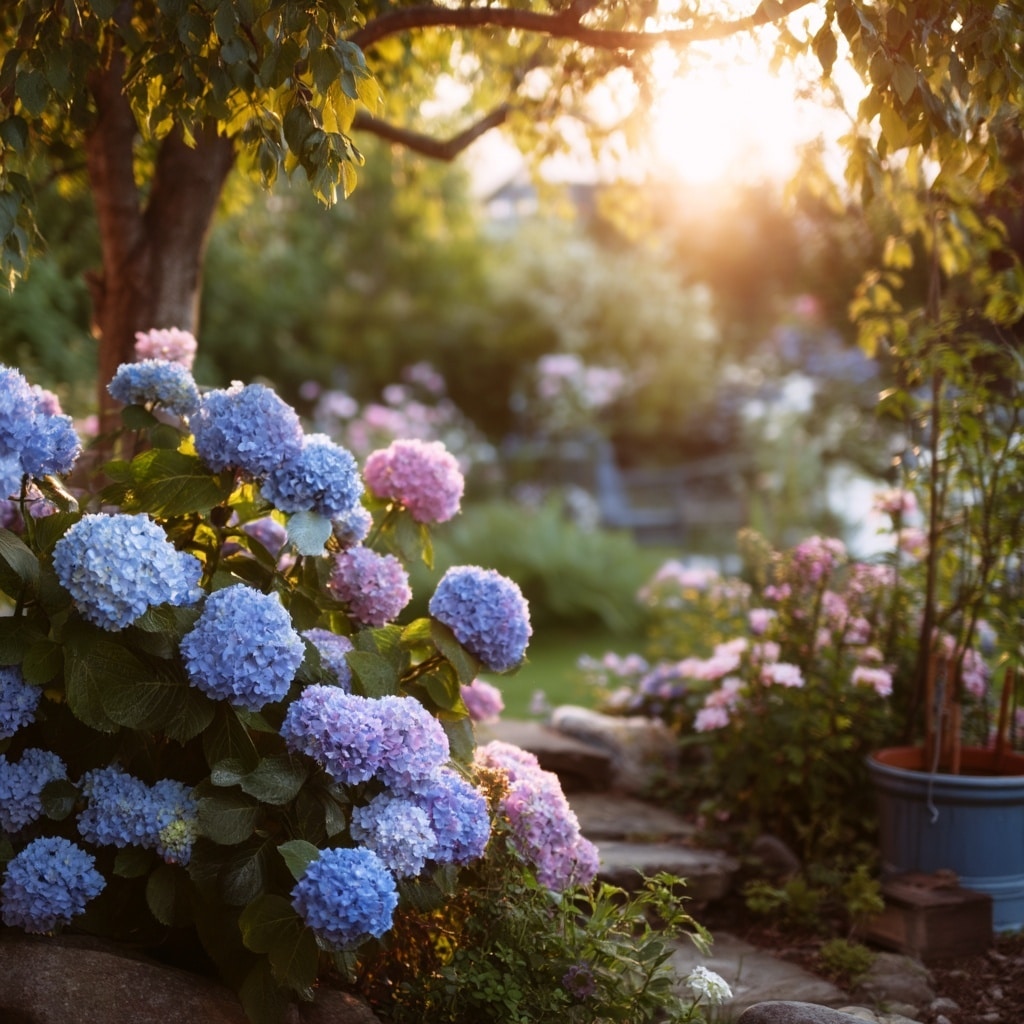
Hydrangeas are a garden favorite for good reason—they offer bold, long-lasting blooms, a variety of colors and forms, and enough versatility to fit nearly any landscape design. With just a little planning and care, you can enjoy their beauty from early summer into fall, year after year.
From understanding the different types to mastering the right planting and pruning techniques, growing hydrangeas doesn’t have to be complicated. Whether you’re looking to add a splash of color to your porch with potted varieties or create a stunning hedge of panicle blooms, there’s a hydrangea that’s perfect for your garden.
So go ahead—dig in, find your favorite variety, and start planting. Your garden will thank you with every bloom.

